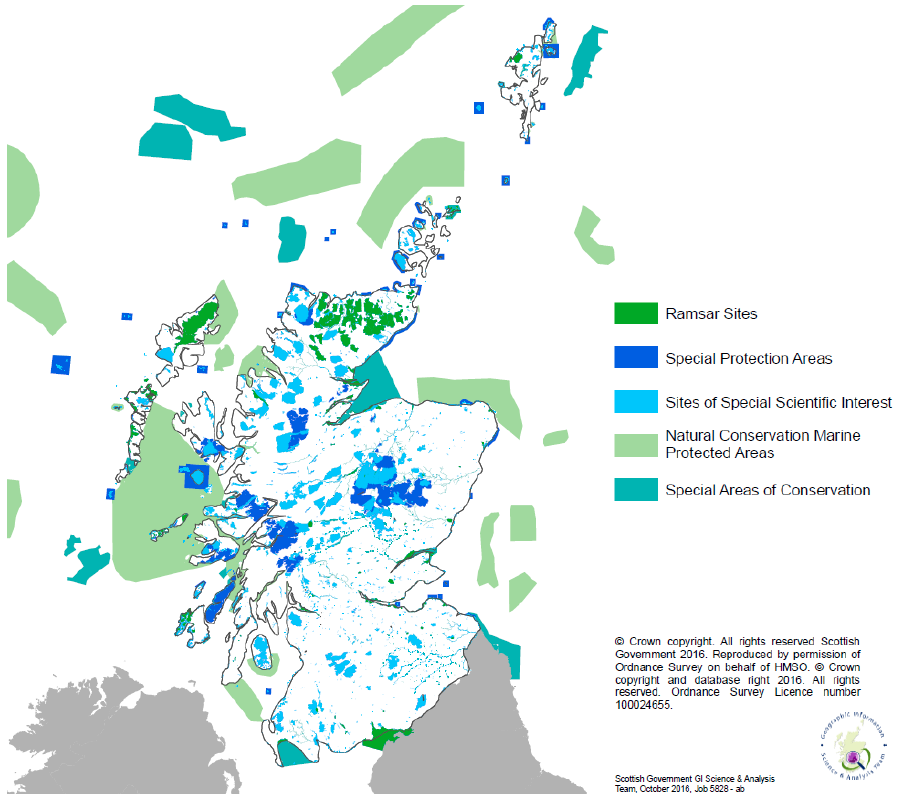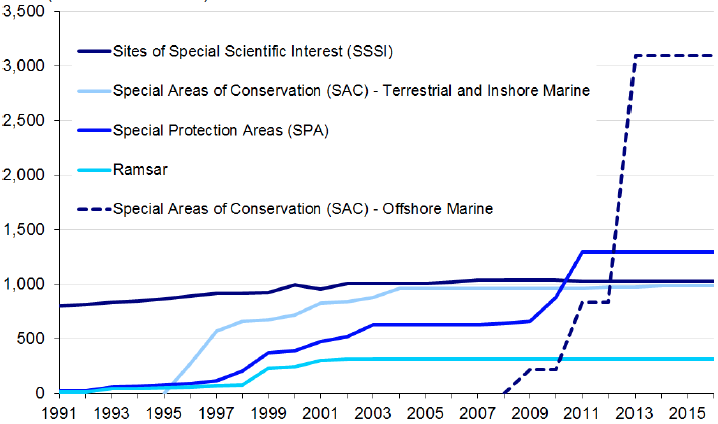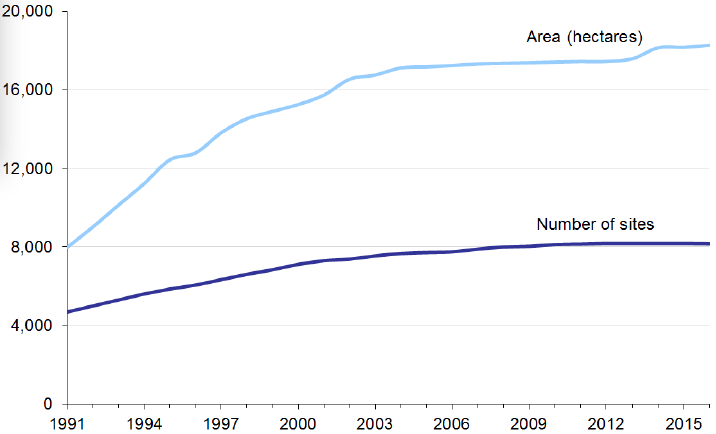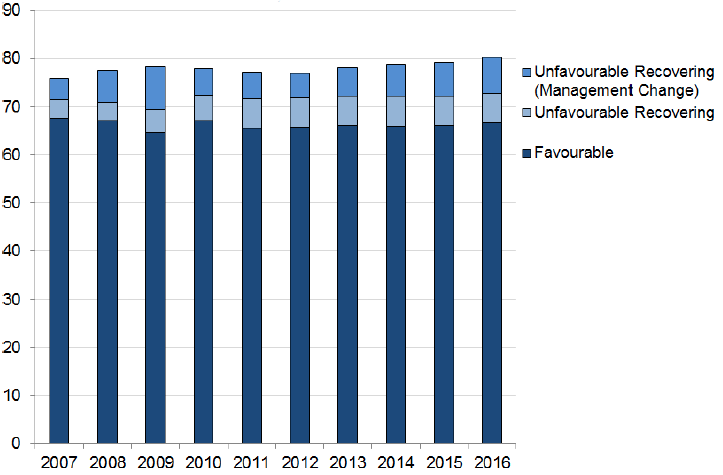Key Scottish Environment Statistics 2016
Reference document offering information on a wide range of environmental topics, covering key datasets.
This document is part of a collection
Conservation
Background
The legal protection of habitats, species, buildings and archaeological sites plays a part in securing their future through preventing damage, destruction or inappropriate exploitation.
Map of Nature Conservation Areas in Scotland

The map above shows the area of many designated nature conservation areas in Scotland. There are also additional areas outwith the area shown on the map (65% of Special Areas of Conservation and 71% of Nature Conservation Marine Protected Areas are located outside the area pictured). Further information on marine conservation areas can be found on Marine Scotland's National Marine Plan Interactive site [116] .
Targets and National Indicators
National Indicators: Improve the condition of protected nature sites
Designated Areas: 1991-2016 [117]
Area (thousand hectares) [118,119] ,

Why this measure is important
Designated areas provide protection for areas of cultural or biological importance.
Background
Designated sites, including Sites of Special Scientific Interest ( SSSIs)[120], Special Areas of Conservation ( SACs) [121] , Special Protection Areas ( SPAs) [122] and Ramsar [123] sites, protect flora, fauna, geological or physiographical features of outstanding quality in terrestrial and coastal environments. In 2016, there were 1,423 SSSIs, 252 SACs, 153 SPAs and 51 Ramsar sites in Scotland.
Trend
The total area of SSSIs in Scotland has steadily increased from 804,000 hectares (ha) in 1991 to 1,022,000 ha in 2016 (about 13% of land in Scotland). The area of terrestrial and inshore marine SACs rose from 0 ha in 1995 to 963,000 ha in 2004 and has since remained broadly stable, rising slightly to 987,000 ha in 2016. In 2016, there were 11 offshore SACs covering a total area of 3,095,000 ha. The area of SPAs rose from 26,000 ha in 1991 to 1,297,000 ha in 2011 and has remained broadly similar since. There are also 30 nature conservation Marine Protected Areas that have been designated to protect marine wildlife and habitats, covering an area of 6,140,000 ha - around 50% greater than that covered by SACs.
Factors affecting trend
In 2009, Scottish Ministers classified 31 marine extensions to existing seabird breeding colony SPAs around Scotland's coasts and classified six new SPAs for golden eagle in 2010, which contributed to the large increase in SPA area of 639,387 ha between 2009 and 2011. The increase of 2,082,000 ha in the area of offshore SACs from 2012 was mainly due to the submission of the SAC at Hatton Bank, which covers 1,569,000 ha.
Source: Scottish Natural Heritage
Metadata
Scheduled Monuments: 1991-2016 [124]
Number and area of sites designated as Scheduled Monuments

Why this measure is important
Historic Environment Scotland is the lead public body set up to investigate, care for and promote Scotland's historic environment. One way it does this is by legally protecting nationally important sites and monuments through designation as 'scheduled monuments'.
Background
Scheduled monuments ( SMs) are protected under the Ancient Monuments and Archaeological Areas Act 1979 [125] . Once a monument is scheduled, the prior written consent of Scottish Ministers is required for most works or activities in the scheduled area to help ensure the monument is not damaged or destroyed - this process is known as 'scheduled monument consent'. Further information on scheduled monuments is available from Historic Environment Scotland. [126]
Trend
The number of SMs has increased by 74% between 1991 and 2016 and the area they account for has increased by 129% over the same period. In 2016, there were 8,167 designated SMs in Scotland, covering an area of 18,285 hectares (ha). There are also 7 historic Marine Protected Areas, covering 87 ha, that have been designated to protect marine historic assets such as historic shipwrecks.
Factors affecting trend
There are SMs spread across Scotland but numbers vary across local authorities. Recent changes may be due to an on-going review of SMs [127] , which may involve the rescheduling, or rationalisation of some sites. Other changes may relate to a review of dual designated sites. [128] Historic Environment Scotland can also add, amend and remove a small number of designated sites in response to external requests to review sites or through day-to-day work in relation to the maintenance of the schedule and list.
Source: Historic Environment Scotland
Metadata
Percentage of natural features on protected sites in favourable condition: 2007-2016 [129]
Percentage of natural features (%)

Why this measure is important
Scotland's protected sites have been identified as areas with 'special' species, habitats, natural rocks or landforms, or a combination of these. Protecting these areas is important for maintaining sensitive or biologically important natural features and makes a key contribution to safeguarding Scotland's biodiversity.
Background
Data are obtained from Scottish Natural Heritage's ( SNH) Site Condition Monitoring programme [130] , and are used to inform the National Indicator: Improve the condition of protected nature sites [131] .
Trend
As at 31 March 2016, 80.4% of natural features on protected nature sites were assessed as being in favourable condition. This figure represents an increase of 1.1 percentage points from 2015 and has increased by 4.4 percentage points from 76.0% in 2007.
Factors affecting trend
This trend can be affected by the actions of the responsible bodies, landowners and users of individual protected sites. Many natural features assessed as unfavourable need specific, and sometimes complex, collaborative actions (e.g. management of wild deer populations) to bring them into favourable condition. Influences from outside the protected site itself, for example climate change, can also influence the condition of individual sites.
Source: Scottish Natural Heritage
Metadata
Contact
There is a problem
Thanks for your feedback